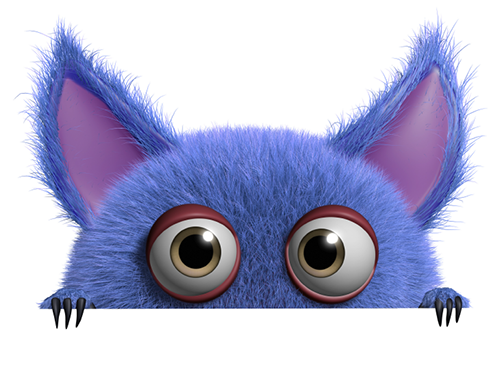Top 5 Popular Monsters and Their Origins
Top 5 Popular Monsters and Their Origins
The Psychology behind Monsters
At the root of humanity lies our fear. Early humans have imagined Gods and Goddesses, often in the form of half-beast, half-man, as a way to explain the world, natural disasters, the seasons, and the cycle of birth and death.
But how did monsters come about? Monsters represent the unknown, our deepest fears, and the eventual death that we all face. Throughout history, there are countless examples of monsters. Some of our most well-known monsters come from an age in which the world was still shrouded in darkness, counting nameless fears in the dark. Yet even today, we are fascinated with these monsters of the deep.
Many have found that through 3D printing technologies they can design and bring to life their own monsters. Learning about some traditional monsters may cause you to look at your own fears and inspire you to create a personalized monster of your own. Let us explore the origins of some of these monsters and the corresponding psychological reasons behind these creatures.
1. Vampires
Vampires are typically attributed to Romania. This is where Vlad the Impaler, also known as Dracula, was from. Vlad was a ruler of Wallachia and his victims are said to be in the tens of thousands, but he was actually known as a folk hero for his protection of the Romanian people. Bram Stoker used Dracula’s name for his novel, Dracula, where we get our most famous example of vampires.
Another facet of the myth and lore surrounding vampires occurred during medieval times. The dead were often blamed for streaks of misfortune, murders, failed crops, and anything else that might go wrong. Villagers would unbury the recently deceased for proof of vampires’ existance and considered the natural decomposition of bodies as evidence that dead walked among them. Things such as long fingernails, bloated bodies, and the presence of blood in the mouth, caused by the bloated body pushing blood up and into the mouth, were cited as proof. Many protections and cures were used, such as garlic, crosses, holy water, and other folk remedies to stave off vampire attacks.
Psychological Roots of Vampires
Since unfortunate events must be explained in some way, and since medieval peoples often did not understand the cause of such misfortunes, another explanation must be made. When someone was murdered or the crops failed, evil must be afoot, and not caused by the ordinary townspeople. Murder in a small village was not common, and who but the dead could commit an act so horrible? Vampires provided an easy explaination, and by staking the corpse in the heart, was easily solved. Then the village was safe once more, at least until the next occurence.
2. Zombies
The myth of zombies comes from real-life Haitian practices. The name zombie likely comes from the word nazambi, which means “spirit of a dead person”. In Haiti, villagers who are problematic may become a candidate for zombification by the Haitian vodoun priests called Bokors. Bokors will give the victim magic powder, which contains ingredients from the porcupine fish or the puffer fish. These fish contain tetrodotoxin, which is a deadly nerve toxin.
Some of the symptoms of tetrodotoxin include numbness, weakness, vomiting, and loss of voice. Breathing and heartbeat is reduced so much that the person is mistaken for dead and buried by the victim’s family. Zombies are then dug up by the Bokor and put in the service of the Bokors, doing work in the fields.
Modern zombies are typically portrayed as mindless corpses reduced to the basic necessity of life, the need to feed. Zombies eat human flesh and have most of their human elements stripped away. In movies, zombies are typically slow-moving with their arms sticking out and little intellegence. However, in other movies, zombies can have great speed and the ability to think and strategize against their unwitting victims.
Psychological Roots of Zombies
Although the flesh-eating zombies are terrifying enough, the idea of becoming a zombie is far worse. Once bitten by a zombie, the victims will become one as well, losing their humanity in the process. This indicates our fear of losing our will and becoming a slave to our needs. By becoming mindless corpses, we lose our ability to choose, to think, and to love. Zombies do not recognize their loved ones and will kill heedlessly. The reckless nature of zombies strikes our fear of extreme violence, which is echoed in our modern society of murders, mass shootings, and war. Some movies, such as Warm Bodies, depict love as a cure to zombiefication. By becoming masters of our will and choosing love over our basic needs, we can defeat the zombie within.
3. Werewolves
There are said to be many ways to turn into a werewolf, from eating the meat of wolf mixed with human flesh, to being conceived under the new moon, to having drunk water that a wolf has drunk from. Some legends said that werewolves had a wolf skin that they could wear in order to change into wolf form. Today, being bitten by a werewolf and then turning into a wolf on the full moon is considered the primary way to become one.
There is also a condition known as hypertrichosis in which the person’s body is covered in thick, long hair. This disease is also nicknamed werewolf syndrome.
Psychological Root of Werewolves
The idea of a “wolf in sheep’s clothing” is an old one. The fear that those among us may be violent, aggressive, and predatory is very real. A werewolf can change its shape, tricking the innocent into believing the wolf will be easy to spot. But in fact, the wolf looks just like anybody else, and may even participate in the “wolf hunt,” and pretend to be helpful. In our everyday lives, we may encounter those who appear friendly but may mean us harm. This may not be a regular occurrence, but at some point each of us has encountered someone whom we considered a friend, only to betray us in some way. The hurt goes deep, and we accuse them of being a wolf.
4. Witches
Witches have been around a long time, from the Greek enchantress Circe to Medieval witches persecuted during the Burning Times. Witches are often condemned in religions as a very real threat to everyday people. Although most people no longer believe in actual witches, in the past, accused witches suffered greatly and were typically tortured and put to death. In tribal cultures, however, the witch-doctor or shaman had a place of honor. The witch-doctor would cure the evil eye, prescribe remedies for physical and spiritual ailments, and guide the tribe through important rites such as birth and death.
Today, such popular stories, movies, and TV shows such as Bewitched, Glinda the Good Witch in the Wizard of Oz, and the Harry Potter series show witches in a positive light. There are still evil depictions of witches, such as found in the TV show Once Upon a Time and in other popular stories.
Psychological Roots of Witches
Midwives have often been accused of witchcraft due to their association with birth, and sometimes, death of the mother or child in childbirth. By assisting in the birth, it was believed that midwives had a unique ability to change, deform, or pollute the child being born. Midwives also had an extensive knowledge about the medicinal properties of herbs, the way the body works, and protections against disease. Since knowledge of these subjects was still largely mysterious, unknown, and little understood, it was thought that these midwives were witches with their store of knowledge and healing powers.
Humans have at times been appalled at how our bodies function, particularly the functions of women, what with menstruation, pregnancy, birthing, and menopause. Oftentimes, a woman was considered unclean or unfit for regular activities during menstration and pregnancy. Some cultures would seclude women during these times until the wome were “back to normal”. Old age was a dangerous time for women as well as great beauty. Old women and beautiful young women were often targets for jealousy, fear, and accusations of witchcraft.
Witchcraft and spells often called for the “living tissue of your enemy or beloved,” such as fingernails or hair clippings. We as humans feel vulnerable about our bodies, especially our hair and fingernails, which are so easily shed or cut. Our vulnerabilities are a reminder that we are mortal, and those who have access to our hair or nails have power over us, and our fear of losing control or being under the power of those who mean us harm. When not in control, we may cause those we love harm or stand in the doorway of death. All sorts of misfortunes, from loss of crops to loss of loved ones, may befall us at the witch’s behest. However, conquering our own fears and accepting what cannot be changed will tame those wily witches that we think are after us.
5. Frankenstein’s Monster
Frankenstein, also called The Modern Prometheus, is a novel by Mary Shelley first published in 1817. In the story, the scientist, Dr. Victor Frankenstein creates the monster through scientific experiments. In the novel, the monster is never given a name, but in popular culture, Frankenstein’s monster takes on the name of his creator.
Psychological Roots of Frankenstein’s Monster
When Mary Shelley wrote Frankenstein, it was during the Industrial Age. Science and industry were peeling back the shrouds of darkness that had covered the eyes of humanity. But the question that many people suffered under was the moral obligations and possible failings of the pursuit of science without religion.
In her novel, Shelley explores the unnatural creation of life without the presence of God. Could man simulate the birth of life without actually going through the natural methods of conception and childbirth? The answer in the novel is that the result will be monsterous, a being that is lonely, cut off from humanity, and ultimately destructive in the face of its creator’s rejection. Dr. Frankenstein becomes the god-figure for the monster, and having been rejected, the monster seeks revenge on those whom Dr. Frankenstein loves. The end is ultimately desolation, apart from the greater part of humanity, where Dr. Frankenstein chases the monster to the North Pole, and finally the death of Dr. Frankenstein.
To understand our own fears, we must acknowledge that the pursuit of knowledge without a sense of ethics and guidelines has the possibility of creating monsters or fostering cruelty. Scientists today have codes of conducts in regards to their experiments. Animal cruelty and dangerous experimentation on living beings, either human or animal, is prohibited. Today, scientists strive to be ever more mindful of the results of experimentation, not to harm in the pursuit of knowledge, but to help.
Confronting our Fears
These are just a few of the monsters that are found in our literature, movies, television, and folk tales. There are many others, all with a psychological reason behind the horror and the fear. When we look within our own minds to touch the seed of fear, we can defeat our terror of these monsters and see that they are, after all, human.
3D Printed Monsters
WhiteClodus is a 3D printing service company and we offer some fun options to celebrate monsters. 3D print your own Spore Monster, Browse Skulls, or Upload your Design of a monster and we will 3D print it for you.



